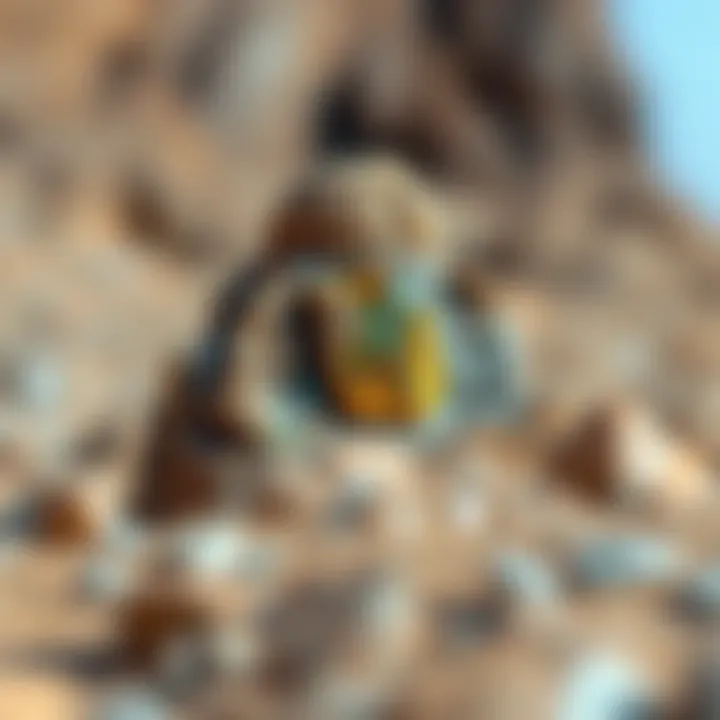Monazite: A Complex Mineral of Scientific Significance


Intro
Monazite stands as a remarkable mineral, characterize not just by its chemistry but also by the vast scientific implications it carries. Primarily made up of rare earth phosphates, it typically includes elements like cerium, lanthanum, and thorium. The relevance of monazite multiplies in contemporary discussions, particularly within geology and material science. As we delve into monazite, we’ll peel back the layers surrounding its formation, application in technology, and its environmental significance.
Research Overview
Summary of Key Findings
Monazite’s intriguing properties and multifaceted applications have attracted the attention of scientists and industries alike. Key findings illuminate its role in:
- Rare Earth Element Resource: Monazite is a rich source of valuable rare earth elements essential in high-tech applications, including electronics, renewable energy technologies, and military applications.
- Geological Insight: The mineral's formation processes reveal significant details about the geological history of Earth.
- Sustainable Extraction: Exploring methods for environmentally friendly mining operations raises substantial questions regarding sustainability and mining ethics.
Background and Context
Monazite is often found in igneous and metamorphic rocks, making it a crucial subject of study for geologists seeking to understand Earth's crust. With the rise in demand for rare earth elements in today's technology-driven world, monazite’s extraction and processing become increasingly urgent. Moreover, balancing industrial needs with environmental safety poses complex challenges.
Methodology
Experimental Design
In studying monazite, a mixed-methods approach proves useful. Analyzing geological samples while employing advanced techniques like X-ray fluorescence ensures comprehensive data gathering. Researchers focus on:
- Field Sampling: Collection of monazite from different geological settings to observe variations in composition.
- Laboratory Analysis: Utilization of spectrometry techniques to assess the mineral's chemical profile.
Data Collection Techniques
Data collection hinges on both qualitative and quantitative methods:
- Microscopic Examination: Identifying the mineral's crystallography.
- Geochemical Analysis: Evaluating the abundance of rare earth elements and associated minerals.
"Understanding monazite not only enhances our grasp of geological processes but also equips us to approach the challenges of modern material demands responsibly."
By intertwining geological study, material science, and sustainability practices, this inquiry into monazite provides a pathway toward informed mineral resource management. The findings gathered here lay the groundwork for further exploration and innovation in both science and industry.
Prelude to Monazite
Monazite stands as a beacon of scientific inquiry, intertwining various fields like geology, chemistry, and environmental science. This mineral, while not widely known outside specialized circles, serves as a crucial benchmark in understanding earth's processes and contributing to advanced industrial applications. Exploring monazite is like peeling back layers of an onion—each layer revealing new insights about not just the mineral itself, but also its broader implications in our world.
The multifaceted nature of monazite makes it imperative to demonstrate its significance in both academic research and practical applications. Known for its high content of rare earth elements, monazite has become a focal point in discussions surrounding resource scarcity and sustainable mining practices. The careful extraction and utilization of this mineral not only promises to enhance technological advancements but also raises vital questions about environmental stewardship and ethical sourcing.
In this section, we will delve into a detailed overview of monazite, exploring its definition and characteristics, along with its historical significance. The aim is to provide a comprehensive backdrop that will support the later discussion of geological formation, chemical properties, extraction methods, and various applications.
Definition and Characteristics
Monazite is primarily characterized as a phosphate mineral with the chemical formula (Ce,La,Nd,Th)PO₄. It often presents itself as a brownish-yellow to reddish hue, appearing as granular aggregates in igneous and metamorphic rocks. One of its standout features is its unique crystalline structure, belonging to the tetragonal system, which gives rise to its distinct physical properties.
- Physical Integrity: Monazite is exceptionally hard and brittle, meaning it requires careful handling during collection and analysis.
- Specific Gravity: With a specific gravity ranging about 4.5 to 5.5, it is considerably denser than many other minerals, making its identification easier in field settings.
- Chemical Variability: The mineral's composition can vary significantly, accommodating a range of rare earth elements which are critical in electronics and energy applications.
Due to these attributes, monazite holds a unique position in the natural sciences, serving as both a geological indicator and a resource in high-tech industries.
Historical Significance
The story of monazite is not just a tale of mineralogy; it intertwines with the evolution of human understanding of the Earth and its resources. Known to have been recognized since the mid-19th century, monazite's initial discovery sparked interests in its potential applications. It was during this era that geologists began to appreciate its role as a host for rare earth elements, a realization that would hasten the mineral's industrial significance.
In previous years, monazite was mainly associated with thorium, sparking interest in nuclear energy long before its extraction for rare earth elements became the norm. Historical mining efforts, particularly in places like the United States and Brazil, set a precedent for how we engage with and utilize natural resources today.
Moreover, the geopolitical dynamics around monazite deposits have historically influenced international relations, especially in contexts where rare earth elements play pivotal roles in technological manufacturing, thus emphasizing its importance beyond geology and into the realm of global economics.


As we journey through this article, recognizing these points will shed light on how monazite has transitioned from a mere mineral to an indispensable component in both scientific research and advanced technology.
Geological Formation
The geological foundation of monazite is of paramount significance, as it informs not only its natural genesis but also its distribution and practicality in various fields. Understanding the processes that lead to the formation of this mineral sheds light on its role in the Earth's crust and ash well as its potential for extraction and use in advanced technologies.
Formation Processes
Monazite often forms through several complex geological processes. It's primarily derived from granitic and pegmatitic rocks that undergo metamorphism. Specifically, the concentration of rare earth elements, phosphorus, and uranium is critical for the crystallization of monazite. During the cooling of magma, these elements become unstable and recombine under extreme pressure and temperature, resulting in monazite's distinctive crystalline structure.
Another noteworthy avenue for monazite's formation is through sedimentary processes. Weathering of parent rocks liberates monazite, which gets transported by water and wind, eventually depositing in specific sedimentary environments. The river systems or coastal areas can serve as ideal locales for such deposits, as minerals are sorted by size and density.
Not only does the formation process play a significant role in the minerology of monazite, but it also determines its isotopic variations which can provide insights into geological time scales and the conditions prevalent during its formation.
Localities of Monazite Deposits
Monazite is not merely a mineral residing in a single locality; it has been found across various parts of the globe, each contributing unique insights into its geological narrative. Some prominent localities include:
- India: Notably the Khondalite belt of the Eastern Ghats, where monazite-bearing sediments are prevalent.
- Brazil: Particularly in the Rio Grande do Norte state, where it forms in placer deposits along the coastline.
- South Africa: Found in effectively managed reserves, contributing greatly to the production of rare earth elements.
- North America: Particularly in regions of Maine and New Hampshire where it appears in granitic pegmatites.
The exploration of these localities is not just about geographical interest; it serves as a springboard for extracting valuable rare earth elements. Understanding where monazite is located can mean the difference between sustainable resource extraction and unnecessary resource depletion.
"Monazite deposits are not evenly distributed; their fractal and localized nature makes their extraction both a challenge and a strategic opportunity."
By diving deeper into these various localities and studying the formation processes, researchers can better grasp the significance and potential of monazite both scientifically and industrially.
Chemical Composition
Understanding the chemical composition of monazite is vital for grasping its significance in various applications, from mineralogy to nuclear science. Monazite primarily consists of a rare earth element (REE) phosphate, which can vary based on the local geological conditions. The chemical formula for monazite is typically represented as [RPO_4], where [R] symbolizes different rare earth elements such as cerium (Ce), lanthanum (La), and neodymium (Nd), along with smaller quantities of thorium (Th) and uranium (U). These elements not only contribute to the mineral’s distinct properties but also to its utility in various fields.
The presence of elements like thorium makes this mineral a key player in the nuclear energy sector. When enriched, thorium can be used as an alternative nuclear fuel, which brings attention to the necessity for safe and efficient extraction methods. Moreover, the unique properties of rare earth elements extend to their roles in technology development, particularly in the manufacture of high-performance magnets and advanced electronic devices.
Mineralogical Properties
The mineralogical properties of monazite are integral to its identification and application. It’s characterized by a resinous luster and a hard, brittle structure, which makes it quite resilient. Typically, monazite crystals appear in yellow-brown colors, providing a visual cue for geologists exploring potential deposits.
- Hardness: On the Mohs scale, monazite usually ranks between 5 and 5.5, indicating that while it is not the hardest mineral, it still retains a notable level of durability.
- Specific Gravity: Monazite boasts a high specific gravity, typically ranging from 4.5 to 5.5. This is due to the presence of heavy rare earth elements.
- Cleavage and Fracture: Monazite exhibits poor cleavage, typically breaking along uneven surfaces, which can guide mineralogists in its exploration.
These properties make monazite an important mineral not just academically, but also commercially, as industries seek to leverage its unique elemental composition for various applications.
Isotopic Variations
Isotopic variations within monazite add a layer of complexity to its study. The isotopes of both thorium and uranium present in monazite make it particularly interesting for geochronological studies. Specifically, the uranium-thorium dating method is frequently applied to determine the age of rocks and sediments. This helps scientists understand geological timelines and the evolution of certain mineral deposits.
- Thorium-232 and Uranium-238: Both isotopes serve as reliable markers due to their half-lives, which are crucial for age determinations. This further shines a light on the geothermal conditions under which monazite forms.
- Radiogenic Lead: As uranium and thorium decay, they produce isotopes of lead, which can also be analyzed to provide context around the mineral's formation and the geological history of its environment.
Research into isotopic variations is not merely academic; it holds significance for understanding present-day mining practices and the sustainability of extracting monazite.
"Monazite isn't just a mineral; it's like a time capsule, holding clues about the Earth’s past and possibilities for our future."
In essence, the chemical composition of monazite encapsulates a treasure trove of scientific insights. By understanding its mineralogical properties and isotopic variations, researchers can harness the potential of this multifaceted mineral in areas spanning energy production to advanced materials science.
Relevant Links
- Wikipedia on Monazite
- Britannica’s Overview
- Nature's Research on Rare Earth Elements
- Environmental Impact Studies
- Geological Society Publications
As we delve further into the narrative of monazite, the implications of its complex characteristics are becoming strikingly clearer. Each aspect contributes to a broader understanding of not just the mineral itself, but also its role in the fabric of industry and ecology.
Extraction Methods


The extraction of monazite is a critical aspect of its utilization, affecting everything from production efficiency to the environmental impact it poses. Understanding various extraction methods not only provides insight into how this valuable mineral is harvested but also underscores best practices and future directions in the field. With a growing demand for rare earth elements utilized in technology and industry, the significance of optimal extraction techniques becomes ever more pertinent in both economic and ecological terms.
Mining Techniques
Mining for monazite requires specialized techniques due to its unique geological settings. It is commonly extracted from alluvial deposits where weathering processes have concentrated the mineral. Here are some primary mining methods:
- Open-Pit Mining: This is often used in areas where monazite is found in high concentrations near the surface. It involves removing soil and rock layers to access the mineral, but it can result in significant land disturbance.
- Selective Mining: In environments with mixed mineral deposits, selective mining allows companies to target monazite specifically while minimizing the removal of unwanted materials. This method often relies on rigorous geological surveying and careful extraction planning.
- Underground Mining: Though less common, underground mining might be employed when monazite deposits are deep. This approach is generally more costly but can minimize surface impact.
Considerations in mining techniques also extend to safety and regulations. Mining operations must comply with both local and international standards to ensure worker safety and mitigate the environmental effects of their activities. The balance between economic gain and ecological responsibility is crucial, leading to increased interest in sustainable extraction methods.
Processing Techniques
After the physical extraction, processing techniques play a vital role in transforming raw monazite into a usable state. The aim is to separate valuable rare earth elements from gangue materials effectively. Key processing techniques include:
- Physical Separation: This encompasses methods like gravity separation and magnetic separation. These techniques utilize the differences in density and magnetic properties to isolate monazite from other minerals without significant chemical changes.
- Chemical Processing: Involving more complex chemical reactions, methods such as acid leaching are employed to extract rare earth elements from the processed mineral. Sulfuric acid can be particularly effective in breaking down the mineral structure to liberate these essential elements.
- Hydrometallurgical Techniques: These are often used for further refining. Using aqueous solutions, these methods can recycle reagents and minimize waste. Adopting more environmentally friendly chemicals can play a part in moving towards sustainable practices in monazite processing.
Using innovative processing techniques allows for maximized yields of valuable materials while reducing the ecological footprint of extraction activities.
"The future of monazite extraction hinges not just on efficient methods but also on the sustainable practices that protect our planet."
As demand for rare earth elements continues to rise, refining extraction and processing methods will be pivotal in ensuring the longevity of monazite as an essential resource. Understanding these intricacies is critical for students and professionals engaging in this dynamic field.
For further reading, visit Wikipedia on Monazite and Britannica for more information.
Applications of Monazite
Monazite serves as a linchpin in various fields, primarily due to its high content of rare earth elements. This mineral's contributions stretch from advanced technologies to essential industrial processes. Understanding its applications not only sheds light on its significance but also the advantages | and considerations that come with its use.
Rare Earth Elements Extraction
Monazite is crucial for the extraction of rare earth elements (REEs), which are vital for producing modern technologies. Within its structure, monazite houses significant amounts of cerium, lanthanum, and neodymium, among others. These elements play indispensable roles in several applications:
- Electronics: REEs are integral in manufacturing rechargeable batteries, catalysts, and high-strength magnets. For instance, neodymium is used in strong permanent magnets, which are essential for electric vehicles and wind turbine generators.
- Optical Devices: The luminescent properties of rare earths make them important in the production of phosphors for LED lights and screens.
- Defence Applications: Some rare earths are critical in developing advanced weaponry and defense systems. Their unique properties enhance the performance of various military technologies.
However, extracting these elements from monazite does not come without challenges. The refining processes can produce environmental pollutants, which necessitates responsible mining practices to mitigate any adverse impacts on ecosystems.
Nuclear Fuel and Research Uses
Apart from its role in extracting rare earth elements, monazite also holds potential in nuclear science. The thorium content found in certain monazite deposits positions it as a candidate for future nuclear fuel technologies. Thorium-based fuel is regarded by some as safer and more efficient compared to traditional uranium-based fuels. The advantages include:
- Safety: Thorium reactors are believed to be less prone to meltdown risks, enhancing overall safety in nuclear power generation.
- Lower Waste: The by-products of thorium reactors are generally less radioactive than those of uranium, offering a potentially cleaner alternative.
- Abundance: Thorium is more abundant than uranium in the Earth's crust, ensuring a more sustainable fuel source for the future.
Research surrounding the utilization of thorium, including its compatibility with existing reactor designs and the development of thorium-fueled technology, indicates promising potential for the future of energy production, making monazite a mineral of high relevance.
Industrial Applications
Beyond the realms of high-tech modernity and energy production, monazite finds its place across several industrial applications:
- Ceramics and Glass: Monazite's components are used in the production of quality ceramics and glass, enhancing their strength, durability, and aesthetic appeal.
- Metallurgy: In the field of metal recovery, monazite can serve as a source of rare metals, which are crucial in high-performance alloys.
- Phosphates in Agriculture: With its phosphate content, monazite is sometimes used in fertilizers to enhance soil nutrients, contributing to better crop yields.
The breadth of monazite applications reflects its versatility, reinforcing its position as an invaluable mineral across various sectors.
In summary, monazite is a multifaceted mineral that serves as a gateway to technological advancement and sustainability. Understanding its applications is vital for making informed decisions regarding its extraction and utilization.
Environmental Considerations
In contemporary discourse about natural resources, the environmental considerations surrounding mineral extraction have become paramount. Within this framework, monazite extraction, often overlooked, presents a double-edged sword. On one hand, the extraction of this phosphate-rich mineral fuels crucial industries, such as electronics and renewable energy. On the other hand, the potential environmental impacts need thorough examination to ensure that we’re not digging ourselves into a deeper ecological pit.
Impact of Mining Activities


Extracting monazite isn’t like snipping a piece of cake. It’s a complex process that can drastically alter landscapes, affect local ecosystems, and influence the well-being of communities nearby. When mining operations are set up without careful planning and monitoring, they can lead to:
- Soil Erosion and Degradation: The excavation process often removes vegetation, which is vital for maintaining the integrity of the soil and preventing erosion.
- Water Contamination: Heavy metals and radioactive elements can leach into local water sources from tailings if proper containment isn’t implemented. This can affect both aquatic life and drinking water supplies for nearby residents.
- Air Quality Issues: Dust and particles can become airborne during mining, which poses health risks not only to workers but also to local communities.
"A balance must be struck – the lure of monazite must be weighed against the potential environmental costs."
Mining must include strict regulations and best practices to mitigate these issues. Removing the mineral without disturbing the environment requires expertise and adherence to sustainable practices. If conducted responsibly, mining can coexist with local ecosystems, enabling both industrial progress and ecological preservation.
Sustainability Practices in Extraction
As the world shifts focus towards sustainability, it’s crucial to adopt practices that lessen the ecological footprint of monazite extraction. Several innovative approaches can help achieve this:
- Rehabilitation of Mining Sites: Restoring land post-mining is essential. Replanting native vegetation can help rebuild ecosystems and reduce erosion.
- Water Recycling: Utilizing water more efficiently during the mining process can drastically reduce the risk of contamination and the strain on local water supplies.
- Responsible Waste Management: Managing tailings with care is vital. This could mean encapsulating waste to prevent leaching into the surrounding environment, minimizing any potential harm.
- Community Involvement: Engaging local populations in decision-making processes helps ensure interests are aligned and fosters a sense of partnership. Supporting local economies through fair practices enhances the legitimacy of mining operations.
Recent advancements in technology also hold promise. Innovations in extraction methods can be tailored to maximize yield while minimizing disturbance to the environment. The future of monazite mining lies in finding that delicate balance between harnessing mineral resources and preserving the earth we all share.
Future Prospects
The strides in understanding and utilizing monazite as a critical mineral signal an exciting chapter ahead for the fields of geology, material science, and nuclear technology. With an increasing global focus on sustainable mining practices and the push to tap into rare earth elements, monazite stands at the forefront of both environmental discussions and scientific innovation. The relevance of this topic extends beyond mere academic inquiry; it offers concrete implications for industries looking to secure their materials while nurturing the planet.
Trends in Monazite Research
Research concerning monazite is currently gaining momentum, propelled by multiple factors, notably the rising demand for rare earth elements used in technologies like electric vehicles and renewable energy solutions. Academic and industrial researchers are diving into monazite's multifaceted structure more than ever, revealing intricate details that may pave the way for more efficient extraction and processing methods.
- Rising Interest in Rare Earth Elements: As nations pursue clean energy initiatives, their reliance on rare earths has put monazite back in the spotlight. There’s palpable excitement in labs as scientists explore extraction technologies that not only enhance yield but also reduce environmental fallout.
- New Analytical Techniques: Advances in analytical methods, such as synchrotron radiation and mass spectrometry, are revolutionizing our understanding of monazite’s isotopic compositions. This is critical for both tracking the mineral’s geological history and fine-tuning its applications.
- Sustainability Studies: Researchers are conducting multidisciplinary studies focused on the environmental impacts of monazite mining. This includes innovative approaches to try to mitigate the risk of radioactive waste generated during ore processing, promising a balanced move towards resource accessibility and ecological responsibility.
The momentum in monazite research reveals a concerted effort to not only understand its geological significance but also to harness its potential in addressing pressing socio-economic challenges.
Technological Innovations
The future of monazite is also brightened by technological innovations that promise to transform its extraction and application.
- Enhanced Processing Techniques: New hydrometallurgical processes are being developed that allow for the efficient separation of rare earth elements from monazite at a lower energy cost, likely enhancing the mineral’s appeal as an extraction target.
- Biotechnological Approaches: Some forward-thinking researchers are exploring the use of microbial leaching techniques to extract valuable minerals from monazite. This could lead to more sustainable and environmentally friendly mining practices.
- Hybrid Technologies: There is a growing trend to develop hybrid systems that integrate conventional mining techniques with cutting-edge robotics and artificial intelligence. These systems could minimize human error and improve the efficiency of the mining operations.
The interplay of these advances is vital not only for maintaining a steady supply chain of rare earths but also for ensuring that the extraction practices are sustainable enough for future generations.
Throughout the industry, there is an increasing recognition of the need for a delicate balance between resource utilization and environmental preservation, especially in light of the pressing challenges posed by climate change.
In summary, the future prospects for monazite involve a combination of innovative research, technological advancements, and an evolving perspective on mining's role in sustainability. As projects move into the pipeline and new ideas are tested, monazite will undoubtedly remain a key player, shaping both scientific explorations and real-world applications.
Ending
The examination of monazite reveals not only its geological and chemical importance but also its significant role in contemporary applications and future innovations. As a complex phosphate mineral, monazite contains vital rare earth elements that hold promise for advancements in technology, sustainable energy, and nuclear applications. The diverse aspects of monazite’s characteristics—from its formation processes to extraction methods—serve to illustrate the intricate relationship between geology and modern industry.
Summary of Findings
In evaluating the various attributes and applications of monazite, we summarize the following points:
- Geological Significance: Monazite signifies crucial geological processes that elucidate Earth's history and its mineral wealth. Its presence is often indicative of unique formations that are rich in rare earth elements.
- Extraction: The methods used to extract monazite, ranging from traditional mining techniques to modern processing approaches, highlight both advancements in technology and the growing need for sustainable practices to mitigate environmental impact.
- Applications: Monazite’s applications, particularly in the realm of rare earth element extraction and nuclear frameworks, can drive forward innovative technologies in energy and materials science.
These elements underscore monazite as a multifunctional mineral that affects various scientific disciplines.
Implications for Future Research
The future of monazite research appears promising, with several key considerations:
- Sustainable Mining Practices: Ensuring that extraction methods adhere to environmental standards is vital. Research into more efficient and less harmful extraction techniques will benefit industry stakeholders and the environment alike.
- Technological Innovations: As technologies evolve, new applications for monazite are likely to emerge, particularly concerning renewable energy and materials science. This opens avenues for interdisciplinary collaboration among geologists, chemists, and engineers.
- Impacts of Isotopic Variations: Understanding isotopic variations in monazite could enhance our grasp of its thermal evolution and stability, contributing to fields like geochronology and nuclear physics.
Thus, continued exploration of monazite presents an opportunity to deepen our understanding of both Earth’s processes and the applications that shape our technological future. Those involved in research and industry alike must consider monazite not just as a mineral but as a pivotal resource fueling innovation across diverse sectors.
“Monazite is not just a mineral; it is a key that can unlock numerous doors to sustainability, technology, and innovation.”
Further resources and references can be explored for more in-depth information. For additional insights, visit Britannica's page on Monazite or consult the scientific literature on mining technologies at Google Scholar.
Overall, the future of monazite remains vibrant, poised at the intersection of science and industry, with the potential to contribute significantly to our understanding and utilization of Earth’s resources.







